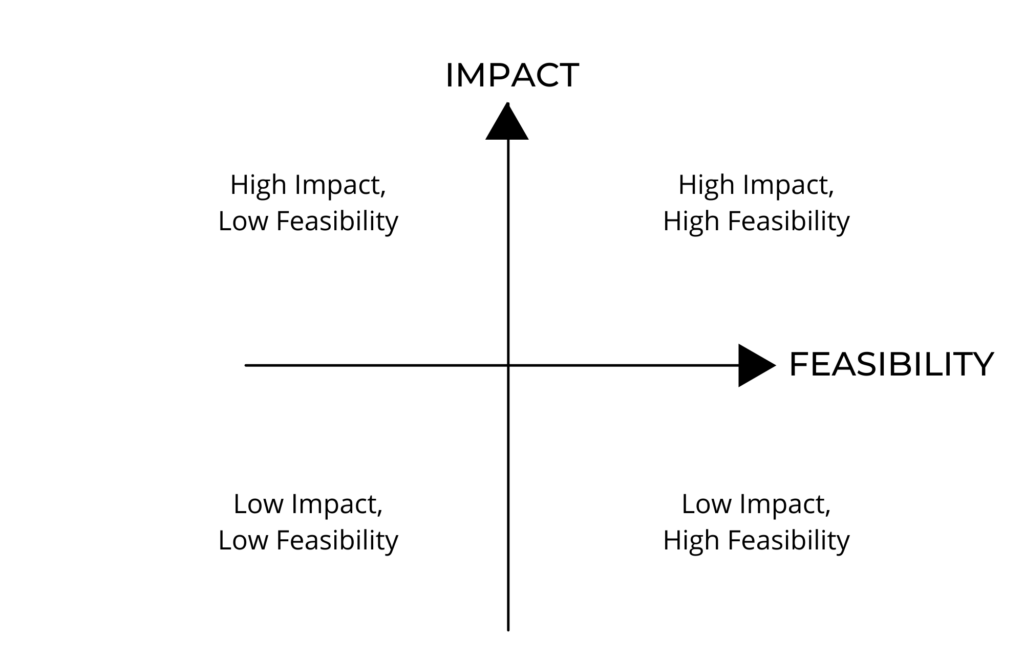Foundation of a Successful Data Project: Creating Space for Solution Mapping
This blog is the second in an ongoing series by the State Chief Data Officers Network at the Georgetown Beeck Center reflecting the best practices and lessons learned by our cohort of participants in Data Labs. The Data Labs initiative helps states launch data-driven economic recovery projects as a result of the COVID-19 pandemic.
February 1, 2022– By Sam Levy
If research and stakeholder engagement are the first steps to understanding the problem that teams seek to solve, the second step is synthesizing that research into a viable solution for the team to pursue.
The City of Boston has some experience in this area when a team from the Inspectional Services Department and students from Harvard Kennedy School decided to investigate the experience of opening a new restaurant in the city. Data on the problem (one in four new restaurants fail!) and insight from stakeholders (can’t get a straight answer from anyone at City Hall on requirements!) provided the team a list of common challenges and pain points from restaurant owners. The list of challenges was extensive, so they started with a brainstorm.
The team generated a long list of potential solutions that directly addressed each feedback they had collected from their research. The solutions were then clustered into themes and plotted and prioritized on an axis of user value and investment. This exercise allowed the team to have a clear understanding of where they should target interventions to add the most value for users while minimizing the resources required by the city.
As a result of this process, the team created two new tools: a feedback mechanism for Bostonians navigating the permitting process with a corresponding user guide for city employees, and a comprehensive user guide that provides step-by-step instructions for opening a new restaurant, helpful checklists, and embedded links throughout for more information.
Taking time to think about all viable solutions and how they relate to the goals and consider the assets on hand, can prevent teams from developing a solution that isn’t ready or viable.
Utilizing an Impact-Feasibility Matrix
In November, Emily Tavoulareas, the Deputy Chair of Tech + Society and Adjunct Professor at the McCourt School of Public Policy at Georgetown University, offered the Data Labs participants a simple and effective tool called an impact-feasibility matrix to identify the right solution to a data project.
An impact-feasibility matrix helps teams to get more clarity on what it is exactly they’re building, buying, or designing. A database? A dashboard? A new policy?

The impact-feasibility matrix can be utilized by doing the following:
- Start with an anything-is-possible brainstorm to generate a long list of solutions and the constraints they need to be designed within,
- Plot those ideas on the impact-feasibility matrix,
- Identify top choices in the high impact/high feasibility quadrant and discuss what needs to be true for this to work, and what would prevent this from happening,
- Select the top solution to pursue.
Rooted in the theory of design thinking, solution design is an iterative process that project teams should revisit throughout the lifecycle of their projects. As knowledge evolves, conditions change and priorities shift. An impact-feasibility matrix is a tool that can assist in facilitating discussion about those changes to ensure project teams maintain momentum and stay moving in the right direction.
Setting S.M.A.R.T. Goals
After determining the best solution to pursue, the next step is to set goals to evaluate progress and measure success.
The S.M.A.R.T. Goals framework stands for Specific, Measurable, Attainable, Relevant, and Time-bound. S.M.A.R.T. Goals are designed to help:
- Identify if what you are setting out to achieve is realistic,
- Determine a timeline,
- Understand exactly what you need to do to realize your desired outcomes.
Conducting a Data Audit
What data is available and what is needed? This is always a critical question when it comes to developing a data project. After identifying the best solution to pursue and setting S.M.A.R.T. goals to evaluate progress and measure success, the Data Labs teams asked themselves the same question.
Data audits capture basic information about the data, such as where it lives, who owns it, how frequently it is collected, and use restrictions. This critical work will inform future conversations around assessing tech needs, negotiating data sharing agreements, and establishing data governance for the project.
Intentional Collaboration
Many ambitious projects have been thwarted by muddled goals, mismatched solutions, or knowledge gaps from missing team members, but that doesn’t have to be the case. Creating time and space for intentional collaboration from all members of a project team (from leadership to project managers to data stewards and everyone in between) is critical. Especially during the solution ideation phase, a diversity of voices, skills, and experiences can lead to project breakthroughs and innovative interventions that you weren’t expecting.
Sam Levy is a Program Manager for the Beeck Center’s State Chief Data Officers Network. You can find her on LinkedIn.